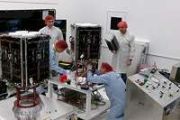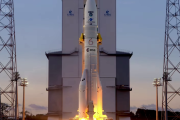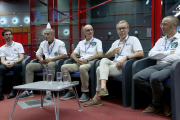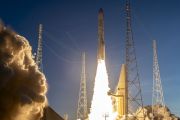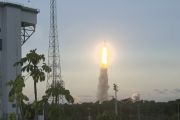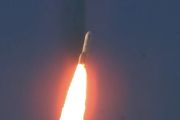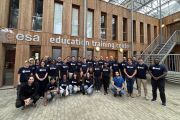
Copernical Team
NASA and Boeing Starliner astronaut 'Butch' Wilmore retires
 Astronaut Barry "Butch" Wilmore announced his retirement Wednesday after 25 years with NASA and serving as a U.S. Navy test pilot before becoming an astronaut.
Wilmore, 62, and astronaut Suni Williams gained a lot of media attention when their 10-day Boeing Starliner test flight turned into a nine-month stay on the International Space Station after lifting off on June 5, 2024, and retur
Astronaut Barry "Butch" Wilmore announced his retirement Wednesday after 25 years with NASA and serving as a U.S. Navy test pilot before becoming an astronaut.
Wilmore, 62, and astronaut Suni Williams gained a lot of media attention when their 10-day Boeing Starliner test flight turned into a nine-month stay on the International Space Station after lifting off on June 5, 2024, and retur Ultrasmall optical devices rewrite the rules of light manipulation
 In the push to shrink and enhance technologies that control light, MIT researchers have unveiled a new platform that pushes the limits of modern optics through nanophotonics, the manipulation of light on the nanoscale, or billionths of a meter.
The result is a class of ultracompact optical devices that are not only smaller and more efficient than existing technologies, but also dynamically
In the push to shrink and enhance technologies that control light, MIT researchers have unveiled a new platform that pushes the limits of modern optics through nanophotonics, the manipulation of light on the nanoscale, or billionths of a meter.
The result is a class of ultracompact optical devices that are not only smaller and more efficient than existing technologies, but also dynamically Perseid meteor shower set to peak Aug. 12-13
 The Perseid meteor shower is set to peak in mid August, allowing stargazers to see up to 100 shooting stars per hour.
The shower takes place each year when the Earth barrels through the trail of ancient debris from the Comet Swift-Tuttle. As the Earth's atmosphere collides with the cometary fragments, the friction vaporizes the debris, creating the flashes of "shooting stars."
Th
The Perseid meteor shower is set to peak in mid August, allowing stargazers to see up to 100 shooting stars per hour.
The shower takes place each year when the Earth barrels through the trail of ancient debris from the Comet Swift-Tuttle. As the Earth's atmosphere collides with the cometary fragments, the friction vaporizes the debris, creating the flashes of "shooting stars."
Th Planning for College? Here's What to Know About Financial Hurdles
 As graduation approaches, high school students are faced with numerous decisions that will shape their futures. Among those pivotal choices, selecting the right college can sometimes take a back seat to another crucial aspect: financing that college education. Understanding financial hurdles is imperative for students and their families as they embark on this journey. These hurdles can sometimes
As graduation approaches, high school students are faced with numerous decisions that will shape their futures. Among those pivotal choices, selecting the right college can sometimes take a back seat to another crucial aspect: financing that college education. Understanding financial hurdles is imperative for students and their families as they embark on this journey. These hurdles can sometimes Light driven visual microphone offers new tool for silent sound detection
 Researchers at the Beijing Institute of Technology have developed a novel type of microphone that captures sound using light, offering a low-cost solution for detecting audio in situations where traditional microphones fall short. Rather than detecting airborne soundwaves directly, this "visual microphone" reads minute surface vibrations triggered by sound, converting them into audible signals.
Researchers at the Beijing Institute of Technology have developed a novel type of microphone that captures sound using light, offering a low-cost solution for detecting audio in situations where traditional microphones fall short. Rather than detecting airborne soundwaves directly, this "visual microphone" reads minute surface vibrations triggered by sound, converting them into audible signals. Parsons and Globalstar advance satellite communications with successful European test
 Parsons Corporation and Globalstar have reached a key milestone in the development of a joint commercial satellite solution, announcing the successful completion of a proof of concept across three European ground stations. The demonstration integrated Globalstar's Low Earth Orbit (LEO) satellite network with Parsons' software-defined communication technology and confirmed operational readiness f
Parsons Corporation and Globalstar have reached a key milestone in the development of a joint commercial satellite solution, announcing the successful completion of a proof of concept across three European ground stations. The demonstration integrated Globalstar's Low Earth Orbit (LEO) satellite network with Parsons' software-defined communication technology and confirmed operational readiness f Training robots for planetary missions from Earth orbit
 This summer, astronauts aboard the International Space Station directed a team of advanced robots through a simulated martian terrain in Germany, concluding the fourth and final session of ESA and DLR's Surface Avatar experiment. The collaborative initiative between the European Space Agency and the German Aerospace Center aims to develop robotic control techniques for future lunar and martian e
This summer, astronauts aboard the International Space Station directed a team of advanced robots through a simulated martian terrain in Germany, concluding the fourth and final session of ESA and DLR's Surface Avatar experiment. The collaborative initiative between the European Space Agency and the German Aerospace Center aims to develop robotic control techniques for future lunar and martian e NASA administrator seeks plan to place nuclear reactor on moon
 Sean Duffy, acting NASA administrator and secretary of transportation, wants to fast-track putting a nuclear reactor on the moon, according to a directive he sent out Thursday.
NASA already has plans to put a small nuclear reactor on the moon but this directive would create a timeline despite the agency's heavy budget cut, Politico, The New York Times and The Independent reported.
Sean Duffy, acting NASA administrator and secretary of transportation, wants to fast-track putting a nuclear reactor on the moon, according to a directive he sent out Thursday.
NASA already has plans to put a small nuclear reactor on the moon but this directive would create a timeline despite the agency's heavy budget cut, Politico, The New York Times and The Independent reported. Sidus Space commissions autonomous SpacePilot system and activates LizzieSat-3 ADCS
 Sidus Space (NASDAQ: SIDU) has successfully activated its proprietary SpacePilot software on the LizzieSat-3 satellite, enabling advanced autonomous guidance, navigation, and control capabilities. The company also confirmed the commissioning of the satellite's Attitude Determination and Control System (ADCS), a critical component in satellite orientation and stability.
These developments m
Sidus Space (NASDAQ: SIDU) has successfully activated its proprietary SpacePilot software on the LizzieSat-3 satellite, enabling advanced autonomous guidance, navigation, and control capabilities. The company also confirmed the commissioning of the satellite's Attitude Determination and Control System (ADCS), a critical component in satellite orientation and stability.
These developments m NASA races to put nuclear reactors on Moon and Mars
 The United States is rushing to put nuclear power reactors on the Moon and Mars, and hopes to launch the first system by the end of the decade.
A new NASA directive - first reported by Politico and seen by AFP on Tuesday - calls for the appointment of a nuclear power czar to select two commercial proposals within six months, framing the push as crucial to outpacing a joint Chinese-Russian
The United States is rushing to put nuclear power reactors on the Moon and Mars, and hopes to launch the first system by the end of the decade.
A new NASA directive - first reported by Politico and seen by AFP on Tuesday - calls for the appointment of a nuclear power czar to select two commercial proposals within six months, framing the push as crucial to outpacing a joint Chinese-Russian 














